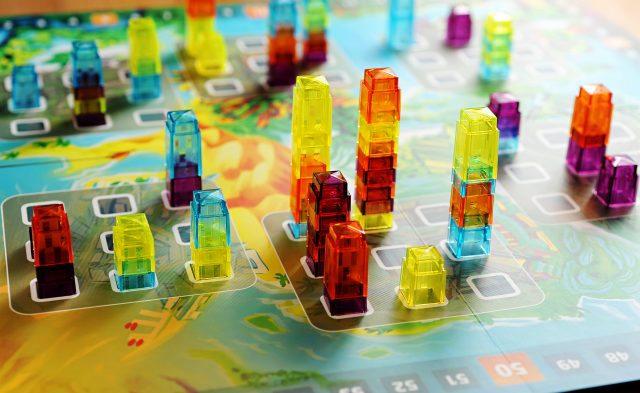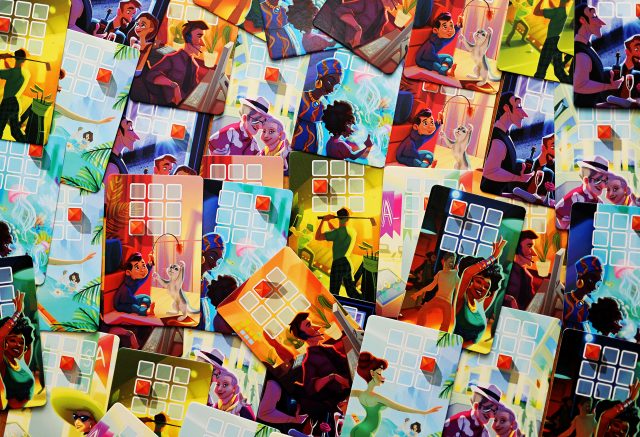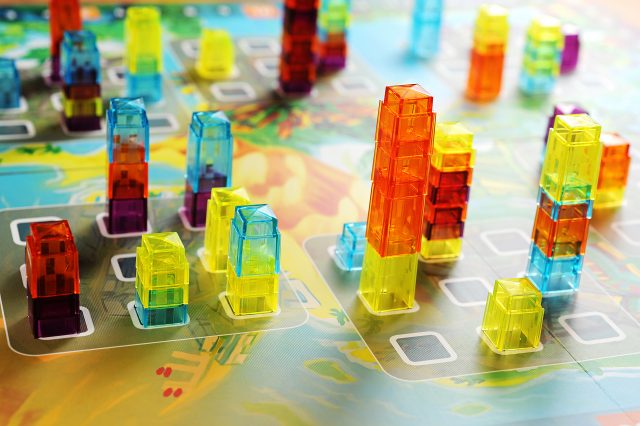When I think of Andreas Seyfarth (as, like any normal person, I do quite frequently), my mind goes straight to titles like Puerto Rico or card-Puerto Rico: San Juan. It’s funny how despite winning a Spiel des Jahres in 1994 for the best game of the year in Germany (and they do know their board games), Manhattan has faded a bit from the public eye. Actually…if we stop to consider it for a moment, is it really that surprising? With so many new gamers being added to the flock every year and so many new games coming out to snatch their attention, an older classic can easily get lost in the shuffle. Enter FoxMind Games. They have brought Manhattan back in a beautiful reprint that is sure to generate some new affection for an excellent abstract.
In the original game, players raced to build skyscrapers on the New York City skyline, reaching new heights, and controlling neighbourhoods. In the reprint, they have become global developers, looking for opportunities around the world. The new version has gotten rid of the drab colours and confines of New York, to embrace a beautiful and vibrant world view. The goal is to build big buildings, and a lot of them in different global locations.
 Manhattan is played by 2-4 people (probably at its best at four). Players each take seats on different sides of the board, so that their perspective is unique. Over the course of four rounds (more depending on player count) they get dealt four Building cards. Based on the cards they’re dealt, they select six Building blocks for the round. Building blocks come in 1,2,3, or 4 levels, and in this new version they are real pretty in transparent colour, replacing the drab black, blue, green, and orange of the original version, that seemed a bit more appropriate for the confines of a big city.
Manhattan is played by 2-4 people (probably at its best at four). Players each take seats on different sides of the board, so that their perspective is unique. Over the course of four rounds (more depending on player count) they get dealt four Building cards. Based on the cards they’re dealt, they select six Building blocks for the round. Building blocks come in 1,2,3, or 4 levels, and in this new version they are real pretty in transparent colour, replacing the drab black, blue, green, and orange of the original version, that seemed a bit more appropriate for the confines of a big city.
The different areas on the board are made up of 3×3 grids, and each of the Building cards indicated a permit to build somewhere within one of those grids. On a turn, a player selects a card and builds one of their blocks in one of the six different areas on the board, respecting where in the grid the card allows them to build. Because each player has a different perspective, each card will mean a slightly different thing to them.
 If you’re placing a block on a vacant space or one where you control the top floor that’s fine, you can do so with no restrictions. However, if another player has the top floor of the building you want to add to, you have to use a piece that will at least leave you tied with that person for the number of floors in the building after you’ve placed. This can lead you to give up your precious 4 floor blocks to secure positions early.
If you’re placing a block on a vacant space or one where you control the top floor that’s fine, you can do so with no restrictions. However, if another player has the top floor of the building you want to add to, you have to use a piece that will at least leave you tied with that person for the number of floors in the building after you’ve placed. This can lead you to give up your precious 4 floor blocks to secure positions early.
Manhattan becomes an interesting game of cat and mouse. You want to know where your opponent might commit their pieces before you make your move. In a four-player game, each person takes a turn with the disadvantages position of making the first move.
At the end of a round, three points are awarded to the person controlling the top floor of the tallest building. Two points are awarded for areas where players have the most buildings. Finally, each building a player controls earns them one point. First player rotates and you repeat for three more rounds.
 Manhattan is a fun, fast game. It’s easy to teach, and a great introduction to abstract games. There is a feeling of always being behind the eight ball, wanting to advance your own interests, while still keeping other players in check. Building cards can usually be used in multiple different areas, so deciding on the right move can taxing and occasionally time consuming. Despite that, the game flows at a pretty fast pace.
Manhattan is a fun, fast game. It’s easy to teach, and a great introduction to abstract games. There is a feeling of always being behind the eight ball, wanting to advance your own interests, while still keeping other players in check. Building cards can usually be used in multiple different areas, so deciding on the right move can taxing and occasionally time consuming. Despite that, the game flows at a pretty fast pace.
It’s easy to see why it won the top German prize many years ago. Since that time, gaming has grown and evolved, but there is definitely still space for this classic on our shelves. The facelift from FoxMind certainly doesn’t hurt. The once drab board now bursts with eye-catching colour and the final results of a game look pretty darn good.
If you were a fan of the original game, or you’re looking to check out one of the titles that starting the board game golden age we currently enjoy, definitely give Manhattan a try.
Don’t you mean the original drab black, grey, sea foam, and coral?
Well, yes…those. 😉